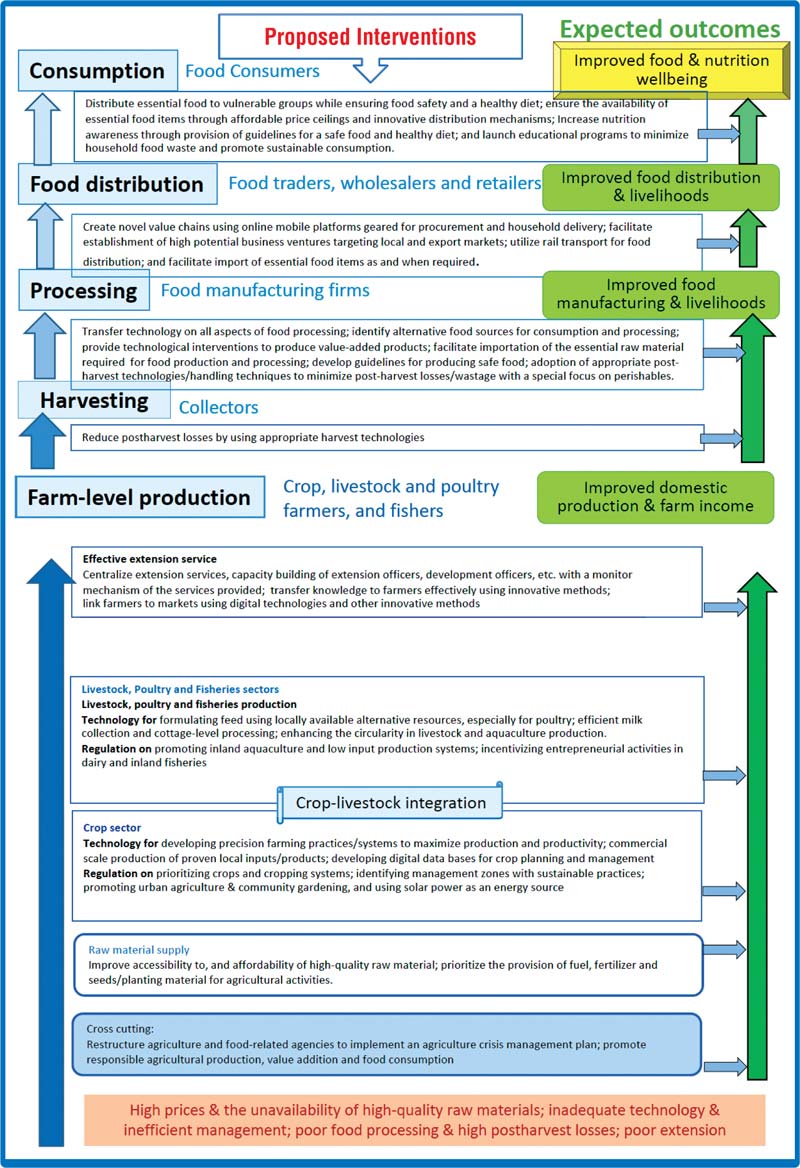Sunday Apr 20, 2025
Sunday Apr 20, 2025
Monday, 20 June 2022 00:04 - - {{hitsCtrl.values.hits}}
Sri Lanka’s economic crisis has caused immediate uncertainties regarding whether; (a) required food supplies are and will be available, (b) the agri-food sector is and will be able to sustain the livelihoods of those engaged in crop, livestock and poultry farming, fishing, food manufacturing, food distribution and allied activities and (c) the agri-food sector is and will be able to provide food security for those most affected by the crisis.
As these concerns are particularly pertinent to the agriculture sector, the Faculties of Agriculture of the State universities of Sri Lanka joined in proposing a plan of action that has been communicated to the President Gotabaya Rajapaksa and the Prime Minister Ranil Wickremesinghe through a letter dated 15 June 2022 and signed by the Deans of all Faculties of Agriculture.
The proposal addresses the present crisis by identifying immediate actions to address the most pressing needs of the current moment and also identifies actions requiring immediate attention that if unaddressed can exacerbate the crisis in the long-term.
The action plan is designed to address the two objectives of ensuring food and nutrition security and of protecting and sustaining livelihoods and employment in the agri-food sector. It focuses on the entire food system considering all economic factors and priority sub-sectors in the agriculture value/supply chains.
The prevailing situation has brought to the forefront serious concerns, especially relating to increases in food prices and shortages in food. Food inflation in Sri Lanka during May 2022 (year-on-year basis) has stood at an all-time high of 57.4%.
The recent appeal from the United Nations (UN) to the global community for $ 47 million in humanitarian aid to Sri Lanka to provide lifesaving assistance to 1.7 million people indicates, to some extent, the extent of the crisis. It is estimated that 4.9, 3.5 and 2.4 million people are in need of food security, agriculture and livelihood, and nutrition, respectively (UN, 2022).
Although national-level data on the depth and breadth of the crisis is unavailable and the situation is still not well understood, we note with concern that if the country continues its current trajectory, especially with respect to the food consumption patterns, it will move beyond crisis into a state of emergency and potentially famine (United Nations, 2022).
Within this context, we recognise and acknowledge the short-term measures adopted to-date by the Government of Sri Lanka to support agriculture; for example, the World Bank and Asian Development Bank assisted the importation of agrochemicals and seed stocks, urea fertiliser was obtained with support from the EXIM Bank of India, and seed paddy supply for the Maha season 2022/2023 is prioritised. This, however, neither reflects the broader set of urgent concerns that the sector confronts nor provides solutions to the overarching problems that we face as a country.
The A Strategy for the Restoration and Rebuilding the Agri-Food Sector of Sri Lanka proposal, submitted by the members of the Faculties of Agriculture of the State Universities of Sri Lanka includes two sections of activities.
The first section is an emergency preparedness plan that specifies a list of actions addressing four broad areas:
(1) immediate food security issues of Infants (under five years of age), adolescent girls, pregnant and lactating mothers, and elderly groups. It recommends a screening process for malnourishment, strengthening pre-school and school lunch programs, the distribution of dry rations and supplements for particularly vulnerable groups.
(2) The estate sector and war-affected areas are identified as a second vulnerable population and recommendations include providing essential nutrients, support with growing food sources for carbohydrate requirements.
(3) To support low-income groups, food rationing to ensure equitable distribution, improvements in marketing and distribution channels, encouragement and support of community kitchens, and facilitation of access to emergency funds and foods through the support of private actors, NGOS, foreign sources are recommended.
(4) Finally, a series of actions to protect industries that are critically important to the nation’s food supplies and foreign exchange, specifically the rice farmers, export agriculture, and poultry industry are identified. These activities must be complemented by awareness, extension and educational programs.
The second section of the proposal includes short-, medium- and long-term actions organised by sector (crop, animal, processing and cross-cutting) and identifies the relevant Government agencies whose attention is sought in implementing each action.
We note that the problems confronted by society today are a result of a lack of a consistent long-term policy and action programs for agriculture, which could have prevented a crisis of this nature from occurring. Such a policy must be developed and must include mechanisms to address future crisis situations by effectively using knowledge, other resources, and institutional structures (state and others).
It must use consultative processes in a holistic manner that ensures that a system to address pressing issues, over the long term, in a sustained manner, is developed in which relevant institutions and bodies are represented with nominees identified through proper channels of communication.
We wish to note that the Faculties of Agriculture are committed to addressing the problems faced by the people of this country and will gladly extend support to any follow up actions of the State in implementing this plan.
